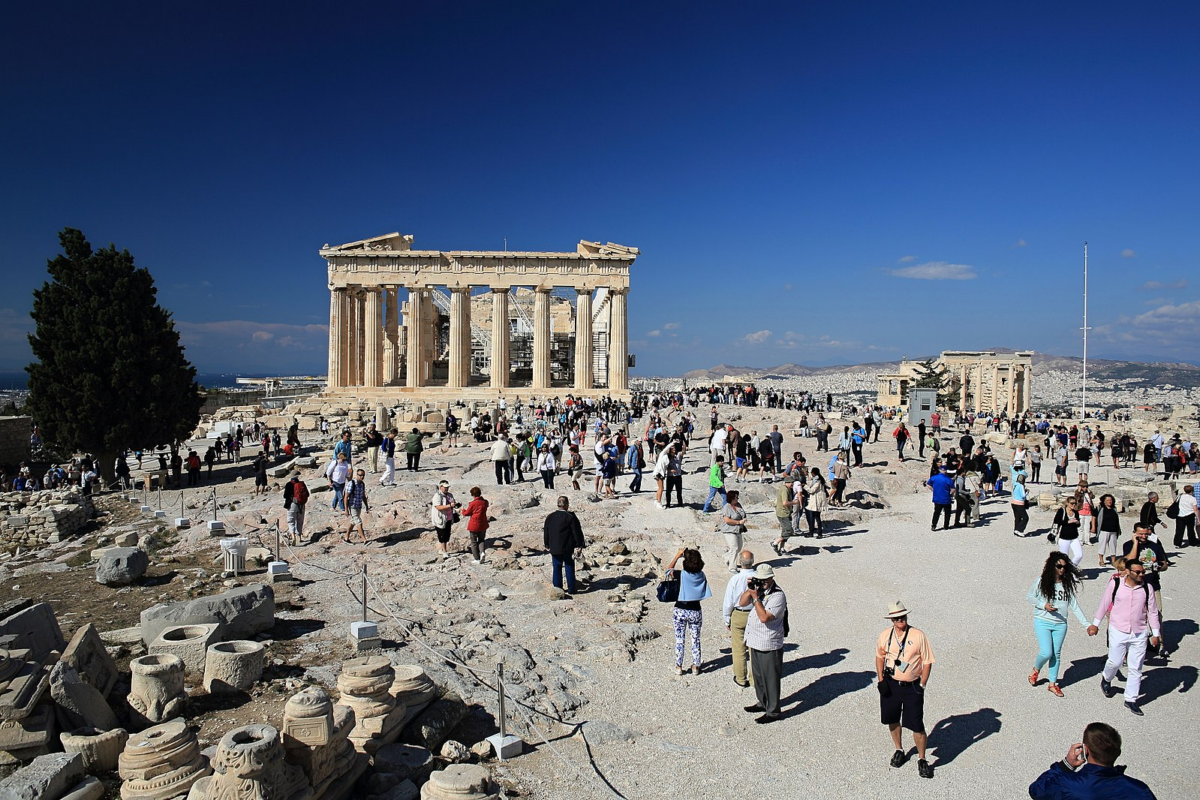A visit to Athens wouldn’t be complete without seeing the Acropolis, an ancient site that is over 3,300 years old. A UNESCO World Heritage site, it is considered the birthplace of Western civilization. Over 16,000 people visit the Acropolis daily, proving its international importance. Traveling to Athens to visit the Acropolis can be a life-changing experience. Here are the best tips on maximizing your trip to the Acropolis, including how to get there, buying tickets, and the best sights to see.
How to get to the Acropolis

If you are staying in Athens, the easiest way to arrive at the entrance to the Acropolis is to take public transportation. The closest station to the site is Acropoli, which is about a two-minute walk from the southeast entrance. You can take the red line #M2 train to arrive at this station. Alternatively, you can hail a taxi to the entrance, although it will be more expensive and may take more time to arrive depending on traffic.
Best time to visit

Being that the Acropolis is one of the most popular tourist attractions in the world, you will be encountering thousands of tourists on any given day if visiting during Athens’ high season between May and September. This can mean very long lines to get into the entrance and large crowds at the monument. It can be very difficult to get a photo at the Acropolis without people in the background if you visit during this time.
The high season in Athens is during the summer when the weather is warmest, however, if visiting during the peak summer months of June-August, be prepared for temperatures between 85-90°F (29-32°C).
With all of this in mind, if you want to visit the Acropolis when there is cooler and more comfortable weather and fewer people, consider visiting during spring or fall shoulder seasons in the spring (April-May) and fall (late September-October). During these seasons, you won’t be climbing the stairs to the Acropolis in the sweltering heat while running into selfie sticks of endless other tourists.
There will be crowds all year round at the Acropolis since it is such a popular tourist destination globally. However, if you want to visit during the season with the least possible crowds, consider visiting during the low season (November-February). This is Greece’s winter, which experiences colder temperatures between 45-60°F (7-16°C). The cold temperatures and rainier conditions make for a less scenic view at the top, however, it could be advantageous if you want to avoid the summer crowds and lines. Other travel costs like airfare, accommodation and food will also be cheaper in Athens for the budget traveler.
How much does it cost to get into the Acropolis?

In order to enter the Acropolis, you need to buy a ticket. Ticket prices vary depending on the season you visit. If you visit between April 1st and October 31st, standard tickets cost €20. If visiting between November 1st to March 31st, tickets cost €10. These tickets offer entrance to the Acropolis, including the North and South Slopes.
If you want to see the most of the Acropolis, you can buy a multi-site/combo ticket, which costs €30 all year round. This ticket includes entrance to the Acropolis as well six additional archeological sites: Hadrian’s Library, the Ancient Agora, the Roman Agora, the Archeological Site of Lykeion, Kermeikos, and the Olympeion. Museums and cemeteries in these sites are also included in the ticket. This ticket is great for ancient history buffs who want to see every single site in the Acropolis, or if you will be in Athens for a longer period of time.
Tickets can be bought at the entrance, however, you may be waiting in a long line to buy them depending on the season you visit. If you want to be more efficient, there are options to skip the line and buy tickets directly online. Some online tickets come with complementary audio guides.
Athens also has designated free entry days to the Acropolis, where all admission to the site is completely free. These days fall on national Greek holidays, which are March 6th, April 18th, May 18th, the last weekend of September, October 28th, and the first Sunday of each month from November 1st to March 31st.
Tour or no tour?

Although access to the Acropolis, Parthenon and adjacent monuments is open to all visitors, there are also countless tours offered by local operators to visit these sites. The decision to join a tour or do a self-guided visit depends on your personal interests.
Greece, especially Athens, is rich in history and culture dating back thousands of years. Since many of the monuments at the Acropolis have a deep ancient history, paying for a guided tour to visit these sites may be worth it.
By going on a tour, you can learn all of the history and legend associated with the Acropolis and city of Athens and learn about the origins of these sites while imagining how they once were lifetimes ago. Guided tours with local, human guides are far better than recorded audio guides or guidebooks, as you can engage with the guide, ask questions, and learn perspectives from a Greek person.
By visiting the Acropolis and learning about its history, you can leave your trip being familiar with its significance, so that you can explain it to your friends and family when they inevitably ask you about it.
In September 2022, Earth Curious took a small group guided tour of the Acropolis site through Airbnb experiences. It was an amazing experience, and it can be booked here. The price per person is €30 + the entrance fees mentioned above.
Other helpful things to keep in mind

- Visit the Acropolis early: Especially in the high season during the summer, the busiest period at the Acropolis is between 11 AM – 1 PM. The site opens at 8 AM, so it is best to arrive in time for opening. For an even more efficient entrance, buy ‘skip the line’ tickets, so you don’t have to wait in line.
- Wear appropriate footwear: Since the Acropolis and the stairs leading up to it are mostly made of marble, you may slip and fall if you don’t wear shoes with good enough traction. Since it takes a lot of walking to arrive to the top, it is best you wear shoes that will not slide and are also comfortable for a long day on your feet.
- Bring appropriate sunwear in the summer: If you are visiting during the summer, be prepared for very hot weather and a lot of direct sun. Since there is not a lot of shade at the top of the Acropolis, make sure you come prepared with sunscreen and a hat to protect your head and face.
- Enter through the southeast entrance over the main entrance: The Acropolis has two entrances. The main entrance is where all guided tour groups enter, so it is the most populated and has the longest entry lines. Instead, opt for the southeast entrance, which is less busy and has a similar length climb to the top.
- Plan your visit duration accordingly: Depending on your physical ability, climbing the stairs to the top of the Acropolis can take anywhere between 1-2 hours. Combined with the sightseeing and picture-taking at the top, as well as the descent back, visiting the Acropolis can be an all-day activity.
Other sites to see
The Acropolis is not just the Parthenon. The hill where the Parthenon sits, and the immediate area surrounding it, have tons of other notable historical sites to see, photograph, and learn about. Here are a few other must-see sites in and around the Acropolis:
The Porch of the Caryatids

Used as columns to support the south porch of the Erechtheion, the “caryatids” or maiden statues are one of the most popular sites in the Acropolis apart from the Parthenon. Believe it or not, the statues that are visible from the Acropolis are actually replicas. The real statues which were originally in their place now reside in the Acropolis museum, and one of them in the British Museum in England. The Erechtheion dates back to 406 BCE.
Ancient Agora of Athens

The Agora of Athens is an archeological site beneath the Acropolis hill. Back during the years of ancient Athens, the Agora was the heart of the city, where various markets, social events, religious gatherings, and political campaigns took place. Its name literally translates to “marketplace” in Modern Greek.
Today, what remains of the Agora are scant structures, but the Temple of Hephaestus still remains largely intact. It is the best-preserved structure ancient Greek temple in the entire country. You can visit the temple and the surrounding Agora with your ticket to enter the Acropolis, but you will have to buy a special ticket which costs €30.
Acropolis Museum

If you are traveling to see the Acropolis, you cannot leave without first visiting the Acropolis Museum, which houses an immense collection of artifacts from Ancient Greece. It has very high acclaim – it is ranked as the 11th-best museum in the world and the 8th-best museum in Europe. Not only does it house some of the rarest and oldest artifacts in the world, but the museum also has impressively beautiful architecture, as it is perched on a hilltop with large glass windows looking over the entire city of Athens. You can see the original caryatids from the Erechtheion here, as well as original marble sculptures and inscribed steles.
Theater of Dionysus

Known as the birthplace of Greek drama, the Theater of Dionysus was the site of performances and plays by famous ancient poets like Aeschylus, Sophocles, and Euripides. Located in the Ancient Agora, the theater dates back to the late 6th century. It was built to honor the Greek god Dionysus, where the ancient Greeks would flock to worship and hold festivals in his honor. Upon entrance, you can openly access the theater and sit in the same seats that the ancient Greeks sat in thousands of years ago.
The Propylaea

When ascending to the top of the Acropolis, you will inevitably cross through the Propylaea, which was considered the grand entrance hall to the Acropolis. In its original composition, the building was an impressive architectural site, with multiple halls, ramps, and doors. Today, its remains serve as the entrance to the first glance of the Parthenon upon entering the top of the hill.
Conclusion

If you want to witness the relics of the beginnings of Western civil society, the Acropolis needs to go on your travel bucket list. Located in the heart of Greece’s capital city of Athens, the Acropolis is a once-in-a-lifetime opportunity to share the same space the ancient Greeks once inhabited. Known as the birthplace of democracy and philosophy, the Acropolis is an incredibly educational travel destination.














